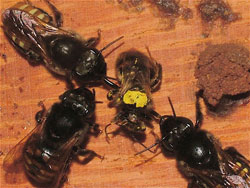Societies of bees, wasps and ants work together in apparent harmony. The queen lays the eggs and the workers do all the other activities such as building and defending the nest, caring for the brood, and collecting food. The fact that the workers have evolved to work altruistically, rearing the queen’s offspring, is because insect societies are families with the queen normally being the mother of the workers. As a result, non-reproducing workers gain inclusive fitness by rearing brothers and sisters instead of sons and daughters. Putting things another way, workers pass on copies of their genes indirectly by rearing siblings, rather than directly by rearing offspring.
 Caste fate conflict. An unneeded queen of the Brazilian social bee Melipona quadrifasciata (yellow paint dot) is killed by the workers soon after emerging from her cell
Caste fate conflict. An unneeded queen of the Brazilian social bee Melipona quadrifasciata (yellow paint dot) is killed by the workers soon after emerging from her cell
The family levels of kinship occurring in insect societies are sufficient to cause workers to act altruistically, but are insufficient to fully resolve conflicts over reproduction. In many species, these conflicts are further resolved by coercion or policing. One conflict concerns 'caste fate'. That is, whether a larva develops into a queen or into a worker. In the honey bee, as in most species, each female larva has the ability to become either a queen or a worker. From the perspective of an individual larva, it is better to develop into a queen than into a worker, but from the perspective of the colony it is better if the larva becomes a worker as this will increase the colony’s productivity. In the honey bee, most larvae are coerced into becoming workers because they are given insufficient food to develop into queens. Only a few are reared in the larger queen cells and fed royal jelly, and so can develop into queens. In Melipona bees, it is not possible for the workers to coerce the larvae by food control as the queen is the same size as a worker, and so does not need more food. This leads to many excess queens being reared only to be killed. Similarly, adult worker honey bees are prevented from reproducing by coercion. Worker bees have ovaries and can lay unfertilised eggs that develop into males if reared. There is a great incentive for workers to lay male eggs as a worker is twice as related to her sons, 0.5, than to her brothers, 0.25. However, other worker bees kill 99 per cent of the eggs laid by workers. This 'worker policing' is so effective that it acts as a deterrent. Most worker honey bees, approximately 99.9 per cent, do not even try to lay eggs. Instead they work.
Coercion by controlling the feeding of female larvae and by the killing of worker-laid eggs occurs in many other species of ants, bees and wasps. Worker insects are to some degree oppressed. But we should not feel too sorry for them. They are gaining inclusive fitness by rearing brothers and sisters. They are not working as slaves.
Selected references
Hughes, W O H, Oldroyd, B P, Beekman, M, Ratnieks, F L W 'Ancestral monogamy shows kin selection is key to the evolution of eusociality'. Science 320:1213-1216 (2008).
Ratnieks, F L W 'Reproductive harmony via mutual policing by workers in eusocial Hymenoptera' American Naturalist 132: 217-236 (1988).
Ratnieks, F L W, Visscher, P K 'Worker policing in the honey bee' Nature 342: 796-797 (1989).
Ratnieks, F L W, Wenseleers, T 'Altruism in insect societies: voluntary or enforced?' Trends in Ecology & Evolution 23: 45-52 (2008).
Ratnieks, F L W, Wenseleers, T, Foster, K R 'Conflict resolution in insect societies' Annual Review of Entomology 51: 581-608 (2006).
Wenseleers, T, Ratnieks, F L W 'Comparative analysis of worker policing and reproduction in eusocial Hymenoptera supports relatedness theory' American Naturalist 168: E164-E179 (2006).
Wenseleers, T, Ratnieks, F L W 'Enforced altruism in insect societies'. Nature 444: 50 (2006).


